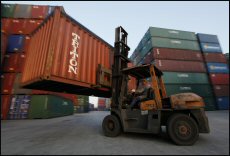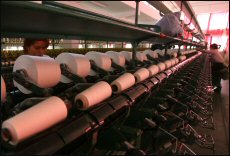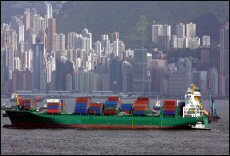 |
|
|
CAFTA has led to better economy of scale between the Chinese mainland and ASEAN (photo: EPN)
|
|
CAFTA and Hong Kong
Although Hong Kong's trade with members of the Association of Southeast Asian Nations (ASEAN) shrank last year, traders can count on good news in the developing relationship between the trade bloc and the Chinese mainland under the fully formed China-ASEAN Free Trade Area (CAFTA).
Hong Kong manufacturers on the mainland can benefit from CAFTA's zero-tariff treatment, and their costs of importing ASEAN products such as rubber and plastics will also be lower.
The 2010 CAFTA deal is also expected to further promote China-ASEAN and intra-Asia trade. Asia's position as a more integrated production base for the global supply chain will help attract foreign investment. Hong Kong could benefit, as a popular choice for regional headquarters and as a service platform.
Trade in Transition
|
 |
|
Under CAFTA's origin rules, consigned products transhipped through a non-CAFTA territory such as Hong Kong, are entitled to preferential tariff agreement
(photo: EPN)
|
The more debatable aspect of CAFTA stems from the fact that Hong Kong is not a member, and so could see a gradual shrinking of trade links as a third party. But the fact is that over the past 20 years, China-ASEAN trade has changed dramatically, with Chinese exports to ASEAN now including value items such as electrical machinery and machinery, ships and boats, as well as minerals and fuels, optical and medical instruments, iron and steel, textiles and footwear. Those trade categories continue to grow wider and deeper. By comparison, China's imports from ASEAN are less diversified, mainly consisting of electrical and other machinery, minerals and fuels, plastics, fats and oils, rubber and organic chemicals. More than 60 per cent of China's imports in 2008 were electrical and other machinery, compared to a 26 per cent share in 1997.
To date, Hong Kong has generally benefited from the flourishing trade between China and ASEAN, thanks to its strategic location, excellent transportation network and business infrastructure. Although Hong Kong's trade with ASEAN shrank by 12 per cent year-on-year in 2009 - with exports and imports declining by 17 per cent and 10 per cent, respectively, over the same period - there was double-digit export growth over preceding years.
CAFTA's Impact
 |
|
|
Although Hong Kong's trade with ASEAN shrank by 12 per cent year-on-year in 2009, there was double-digit growth over preceding years (photo: EPN)
|
|
While CAFTA has led to better economies of scale between China and ASEAN - with lower production costs, higher efficiency and economic growth - there are concerns that Hong Kong could suffer from trade diversion. Though CAFTA members are expected to benefit, logic dictates that trade with non-members could decline due to CAFTA's tendency toward member preference. The mainland and ASEAN are Hong Kong's largest and third-largest trading partners respectively. About half of Hong Kong's exports go to the mainland and Hong Kong remains the mainland's largest source of inward foreign direct investment.
Since the bulk of Hong Kong manufacturing takes place on the mainland, CAFTA's import tariff cuts will be extended to Hong Kong manufacturers so long as they comply with the required country-of-origin rules. The big question is the extent to which trade diversion will take place where it comes to Hong Kong's major exports to CAFTA.
Given the CAFTA tariff cuts, most of the trade volume growth can be expected in direct trade between China and ASEAN. That could well mean a shrinking share of re-export trades via Hong Kong. But the picture is not entirely cut-and-dried. If one compares the compound annual growth rate (CAGR) differential between 2002 and 2005 and between 2006 and 2008 (when CAFTA tariff cuts were implemented), a different picture emerges.
The average annual growth of total China-ASEAN trade was 23 per cent from 2002 to 2005, and dropped to a CAGR of 20 per cent during the period 2006 to 2008. This highlights the fact that China-ASEAN trade didn't pick up significantly in the first three years after CAFTA tariff cuts were implemented. Nonetheless, Chinese exports to ASEAN rose between 2006 and 2008, with CAGR surging from 20 per cent in the four years to 2005 to 27 per cent in the three years to 2008.
Meanwhile, Hong Kong posted double-digit growth in both its trade with ASEAN or re-exports of China-origin to ASEAN in the period 2002 through 2008. Broadly stated, CAFTA tariff cuts introduced from July 2005 did not lead to any substantial, adverse trade diversion during that period. (This analysis purposely excludes 2009, because international trade was severely disrupted by the global economic downturn.)
2011-06-14 - Article 1
Global Insight service forecasts 8.5% growth in trade by all transportation modes, Additional container ship capacity is expected to be taken back into service in the near future as new services are opened and vessels reduce their cruising speed.

World trade by all modes of transportation, rebounding strongly from a deep dive during the global economic crisis, will grow 8.5 percent in 2010, according to the latest forecast from IHS Global Insight's World Trade Service.
Total world trade is expected to grow 7.8 percent in 2011.
Carriers are beginning to respond to an upturn in cargo volumes by increasing capacity, according to the First Quarter Trends in World Economy and Trade report from the IHS Global Insight World Trade Service.
Trade volumes on the Far East to Europe routes are forecast to rise 8.0 percent in 2010. The export trade from Europe to Asia grew in 2009 and is expected to grow in 2010
Transpacific eastbound trade - from Asia to North America - began to recover in the third quarter 2009, though the downturn in 2009 was 18 percent, and is forecast to grow 10 percent in 2010. Solid growth is forecast for westbound trade after two years of decline. Eastbound transatlantic trade from North America to Europe is forecast to return to 2007 levels by 2013. However, westbound transatlantic traffic will not recover to 2007 levels until 2015.
Major container shipping operators recorded huge losses in 2009. However, in February and March 2010, the number of container ships in layup diminished and stood at 1.2 million TEUs (one TEU is one 20-foot container or its equivalent), or 9.1 percent of the container fleet on March 1, the lowest level since July 2009.
Additional capacity is expected to be taken back into service in the near future as new services are opened and vessels reduce their cruising speed. The outlook for bulk shipping also is improving following a dramatic reduction in bulk commodity trade over the past year. IHS Global Insight forecasts bulk trade to grow 8.9 percent in 2010 as commodity consumption demand recovers.
Dry bulk commodity shipping tonnage, including grain, iron ore and coal, fell 2.0 percent in 2009 but is forecast to grow 9.4 percent in 2010, despite decreases in global grain shipments. Liquid bulk trade - petroleum, liquefied natural gas, and chemicals - is forecast to grow 8.5 percent in 2010. With the oil market well supplied with spare productive capacity of 6 million barrels per day and ample inventories in 2010, trade may continue to rise.
|



